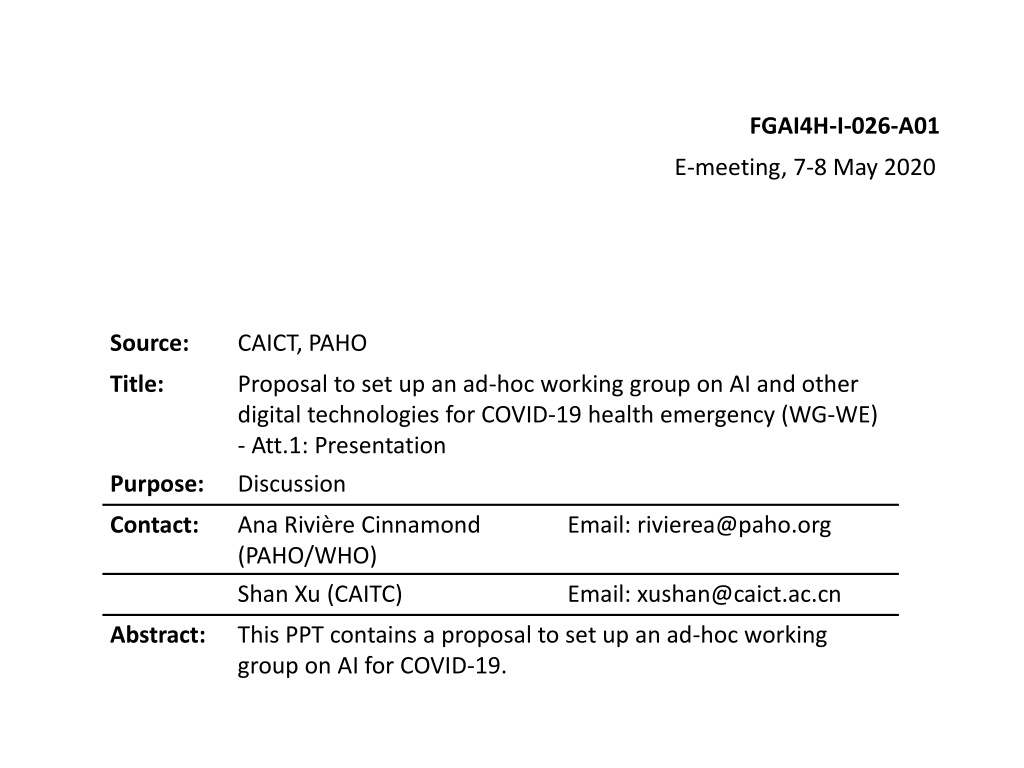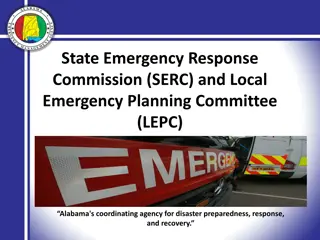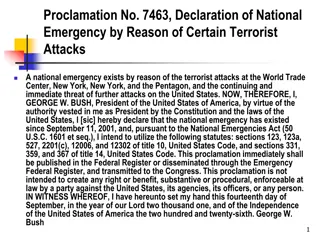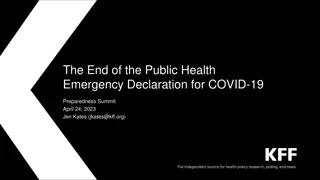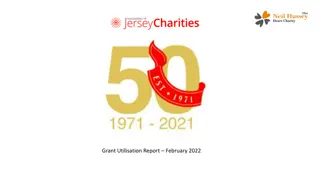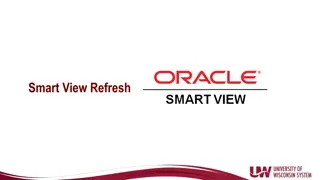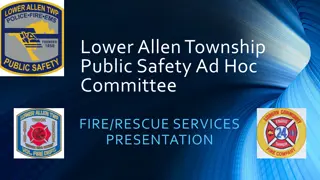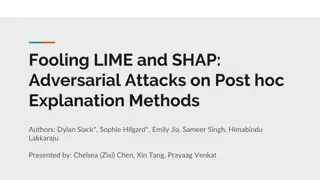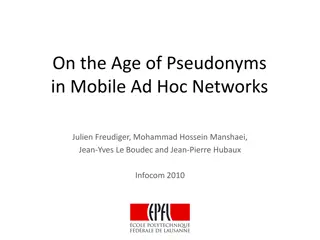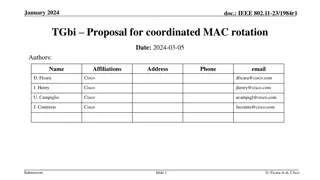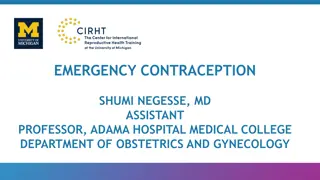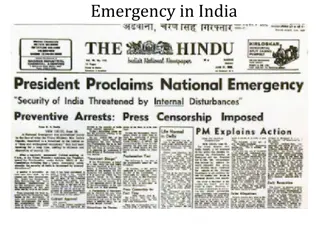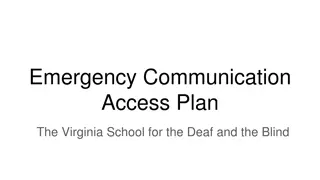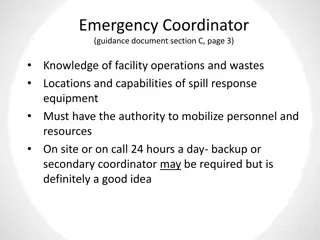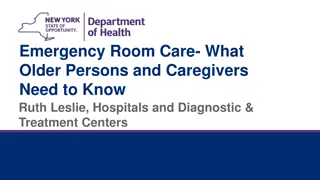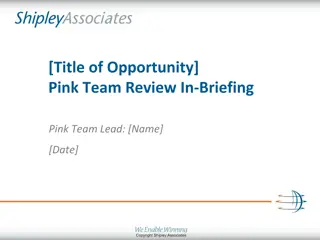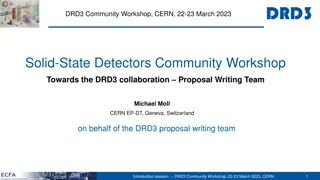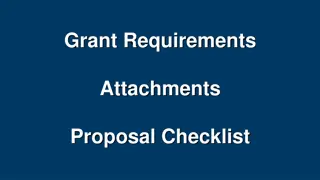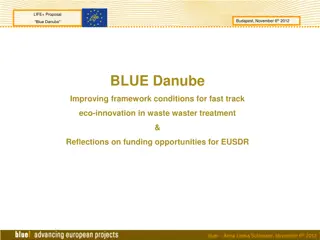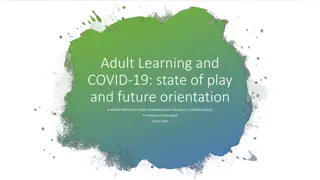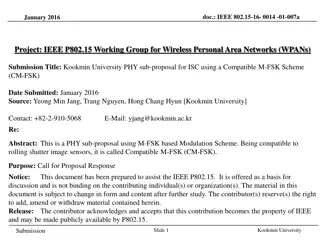Proposal for Setting Up Ad-Hoc Working Group on AI for COVID-19 Health Emergency
Presentation proposing the establishment of an ad-hoc working group focused on utilizing AI and digital technologies to combat the COVID-19 health emergency. The group aims to cover various stages of epidemic emergencies, including prevention, preparedness, outbreak detection, surveillance, recovery, and mitigation. Specific issues addressed include the urgency in fighting COVID-19, collaboration with existing groups, and future research activities such as risk assessment and monitoring. The proposal emphasizes the importance of leveraging technology to enhance public health responses during pandemics.
Download Presentation

Please find below an Image/Link to download the presentation.
The content on the website is provided AS IS for your information and personal use only. It may not be sold, licensed, or shared on other websites without obtaining consent from the author. Download presentation by click this link. If you encounter any issues during the download, it is possible that the publisher has removed the file from their server.
E N D
Presentation Transcript
FGAI4H-I-026-A01 E-meeting, 7-8 May 2020 Source: CAICT, PAHO Title: Proposal to set up an ad-hoc working group on AI and other digital technologies for COVID-19 health emergency (WG-WE) - Att.1: Presentation Purpose: Discussion Contact: Ana Rivi re Cinnamond (PAHO/WHO) Email: rivierea@paho.org Shan Xu (CAITC) Email: xushan@caict.ac.cn Abstract: This PPT contains a proposal to set up an ad-hoc working group on AI for COVID-19.
Proposal to set up an ad Proposal to set up an ad- -hoc working group on AI hoc working group on AI for COVID for COVID- -19 19 Ana Rivi re Cinnamond (PAHO/WHO) Shan Xu (CAITC)
Introduction Introduction
Rationale Rationale WHO proposed a collection on anonymized COVID-19 clinical data and built a data platform for COVID-19 clinical data ITU-WHO released a Joint Statement on unleashing information technology to defeat COVID-19 The World Bank, the International Telecommunication Union (ITU), GSMA and the World Economic Forum launched COVID-19 Crisis Response: Digital Development Joint Action Plan and Call for Action Extraordinary G20 Digital Economy Ministerial Meeting: COVID-19 Response Statement (Apr 30)
Scope Scope This ad-hoc working group on COVID-19 health emergency (WG-HE) is aimed at covering the entire cycle of an epidemic emergency, encompassing the following: prevention and preparedness, outbreak early detection, surveillance and response, recovery, rehabilitation, mitigation, etc. In the short-term, this group will collect effective ways and cases on AI and other digital technologies to combat COVID-19 at the above stages. In the future, this work could contribute to a general experience on the analytics and scenario setting as a continuous exercise during the emergency cycle feeding each stage and evolve towards a more generalizable mechanism on the health emergency continuum, eventually applicable to other pandemics.
Specific issues Specific issues Targeted to COVID-19: With the urgency on fighting against COVID-19 worldwide, this ad-hoc WG focuses on the COVID-19 pandemic. No conflicts with TG-Outbreak nor with TG-Symptom: The TG-Outbreak focuses on AI solutions on early detection of outbreaks, and this group plans to cover the many stages of epidemic emergency. TG-Symptom focuses on AI solutions to identify possible pathologies based on syndromic description by patients. This ad-hoc WG will collaborate, reuse and share mid or final outputs with the applicable FG-AI4H TGs. Further research in the future: Collection and collaboration on COVID-19 digital cases are not the only activities of this ad-hoc WG. Further research such as risk assessment, monitoring and evaluation, analytics and scenario setting as a continuous exercise during the above emergency cycle will be conducted. We expect a generalized experience extracted from this COVID-19 work, eventually applicable to other health emergencies.
Lessons learned to inform change: systematizing findings, feeding to policy changes Facilitating movement restrictions: food and medication delivery, medical follow up, teleworking, home schooling etc. New ways of living: technologies that will facilitate social distancing while allowing to continue with work and personal life Prevention Recovery and rehabilitation Preparedness Movement restrictions/ control/ lifting of measures: Contact tracing, facial recognition, PEPP-PT etc. ethics TG Symptoms: global syndromic surveillance data availability Mitigation Surveillance AI Laboratory: improving testing bottlenecks (capacity, timeliness) at each stage TG Outbreaks: global monitoring of epi data, media monitoring ethics Early detection Early detection of cases: geolocation, movement, facial recognition etc. Containment Response Clinical diagnostics: speeding triag, diagnostic and treatment techniques (imaging, clinical algorithms) Analytics: capacity to assess the risk at local, national and international levels (data needs on mobility to quantify possible spread )
Existing work Existing work CAICT (China) best practice reports on digital health cases in the prevention and control of COVID-19 in China: with more 200 digital cases were collected (AI, 5G, Internet, IoT, Virtual hospital, etc.), and the series of reports(V1, V2, V3, V4, EN) started in Jan 2020 is regularly updated. CAICT s digital health demand and supply platform: Over 500 companies and enterprises are engaged and published their digital products and solutions on epidemic prevention and control. This platform is now supporting NHC on international supplies supporting for countries. Technologies for digital contact tracing are being used to monitor how efficiently social distancing measures are being applied across cities/countries. Different techniques have been explored and tools (such as apps) developed, e.g. Google or Waze metadata, Fitbit, Bluetooth and different social media platforms metada, covidApp etc. General concerns include privacy and confidentiality of data, which can be a factor in adoption. Some estimates indicate that digital contact tracing, to be effective, would require adoptions of 60% or more within a monitored population.
Deliverables Deliverables Nurture the creation of a network of experts that can be a reference group for addressing the use of AI and other digital technologies for tackling health emergencies such as the COVID-19 pandemic. Develop a collection of best practice or case collection that can be referenced globally that leverage AI and other digital technologies in combating COVID-19, build suitable mechanisms on sharing these experiences. Reports on risk assessment, monitoring & evaluation of different digital interventions on COVID-19. Develop a framework to cover the entire cycle of an epidemic emergency and provide guidance on digital interventions feeding each stage. Provide, as appropriate and upon request, input to WHO development processes for guidelines on the use of AI and other digital technologies for tacking health emergencies. Providing guidance for public health considerations on the use of AI and other digital technologies for tackling health emergencies. Other possible collaboration output within the network (e.g. With Ethics, with Outbreak, with Symptoms, with Xray solutions etc.)
Representations and interactions Representations and interactions Chairs and experts of FG-AI4H WG and TG members with relevant expertise and interest ITU and WHO experts G20 and other international mechanisms Workshops to include participants from government agencies, academic institutions, NGOs and National Health Committees Participants in this ad-hoc WG will follow the procedure in Document FG-AI4H-F-105. FG-AI4H F-105 (Zanzibar, September 2019)), ToRs for the WG-Experts and call for experts and Annex A, Application form; Conflict of interest form
Thank you! Any question or suggestion?
